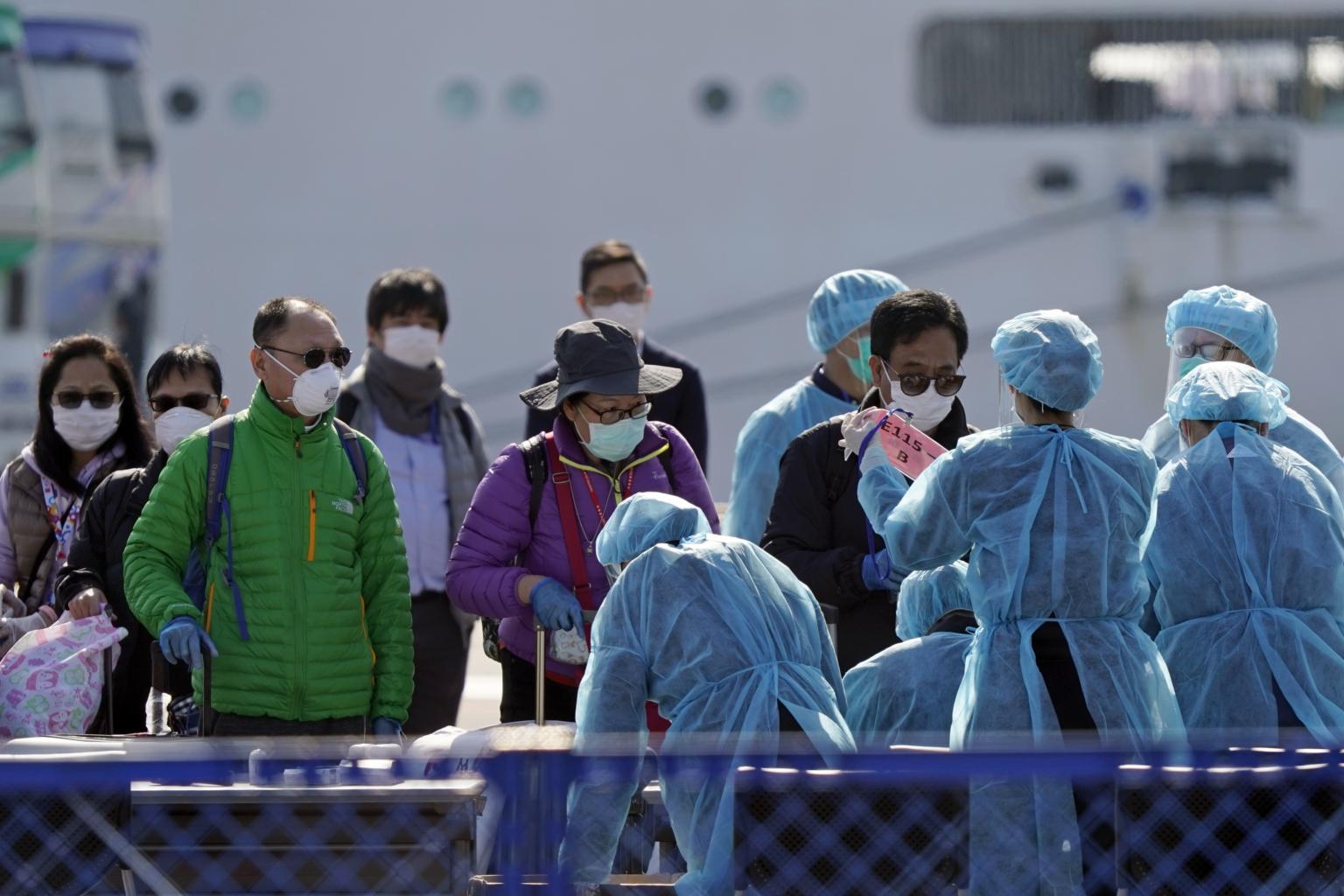Coronavirus: Epidemic enters new phase as cases outside China multiply
Sign up now: Get insights on Asia's fast-moving developments

Workers in protective gear screening passengers as they disembark the Diamond Princess cruise ship at the Daikoku Pier Cruise Terminal in Yokohama, Japan, on Feb 21, 2020.
PHOTO: EPA-EFE
Follow topic:
TOKYO (BLOOMBERG) - South Korea has more than 150 cases. Singapore and Japan have topped 85. And then there are the 600-plus from a quarantined cruise ship in Japan.
As the cases of coronavirus infections mount, worries are growing that the outbreak is entering a concerning next phase. Where China had the vast majority of cases and deaths before, there are now signs that infections are spreading more rapidly within other Asian countries beyond its borders.
For now, China still remains the centre of the crisis, with 75,000 infections. But as the number of net new cases there declines, attention is shifting to the risks in other countries where the growth in infections is accelerating.
Anxiety is already creeping into global financial markets as investors weigh the impact of a wider regional outbreak on economic growth and corporate earnings.
"The sudden jump in infections in other parts of Asia, notably in Japan and South Korea, has sparked renewed concerns," said Mr Khoon Goh, Singapore-based head of Asia research at Australia & New Zealand Banking Group.
"This points to a new phase in the outbreak, and one which will see continued disruption and more economic impact than previously thought."
MARKED UPTICK
The epidemic that emerged in early December has yet to become a pandemic, which is defined as a situation where the virus is spreading across multiple continents.
So far, the numbers outside of China remain small: Out of 2,247 deaths, only 11 have occurred in other countries. Yet there has been a marked uptick in non-China cases this week.
South Korea has seen a fivefold increase in infections, with a surge of cases tied to a cluster from a religious sect in Daegu. At least 82 cases involve those who may have attended church services with a person who was confirmed with the virus earlier this week.
South Korean Health Minister Park Neung-hoo said the authorities are aware of transmission channels and the current situation is "manageable".
Daegu has shut down public facilities and advised residents to stay indoors to try to contain the disease.
More alarming is the situation in Japan, which has emerged as one of the riskiest places for the spread of the coronavirus.
Health Minister Katsunobu Kato said on Sunday (Feb 16) that Japan had lost track of the route of some of the infection cases, which have tripled in the past week to more than 90.
Diamond Princess
Japan is seeing cases in multiple, unconnected areas across the country and the authorities have been scrambling to understand where they are coming from.
The government is being faulted for being too slow to bar visitors from China and too lax in its 14-day quarantine of the Diamond Princess cruise ship, the vessel with 3,700 passengers and crew that's been under the global spotlight.
At least 636 of them have been infected by the virus and two have died.
The situation has the potential to escalate, given the presence of high-risk factors like Japan's elderly population and a societal work ethic where taking a sick day is often frowned upon.
The US Centres for Disease Control and Prevention has issued a Level 1 alert for Japan, which does not discourage travel to the country but urges caution.
CONTAINMENT EFFORTS
To be sure, Japan's advanced healthcare system puts it in better stead to fight the outbreak than poorer states with fewer resources like China's neighbour North Korea, and countries in sub-Saharan Africa.
There is also progress being made in Asian cities where strict containment measures have been put into place.
The Chinese-controlled territory of Macau, the world's biggest gambling hub, has not reported a new infection in more than two weeks as casinos were shut and travel to mainland China was restricted.
While Singapore has more than 80 cases, the rate of new infections has been steady, and 37 patients have so far recovered.
Hong Kong similarly has not seen a surge. That could change, however, with the case of a police officer infected with the virus. He had a meal with 59 other officers, who are now in quarantine.
POWDER KEG
Some believe that the Diamond Princess cruise ship could be a potential powder keg as more than 1,000 quarantined passengers leave by the end of Friday.
With people aboard hailing from more than 50 nations and now returning back home, their travels could spawn a fresh wave of global infections.
On Friday, two people evacuated to Australia from the cruise ship tested positive for the virus.
"It's entirely possible to get tested, be negative and get on an airplane and be positive once you land," said Dr Keiji Fukuda, the director of the School of Public Health at Hong Kong University and a former World Health Organisation official who has led responses to outbreaks. "That's just how infections work."
For now, the WHO says the situation is still manageable, but warns that if countries don't take the situation more seriously, the spread will become a wider global threat.
"The virus is very dangerous and it's public enemy No. 1," director-general Tedros Adhanom Ghebreyesus said at a briefing in Geneva on Thursday.

